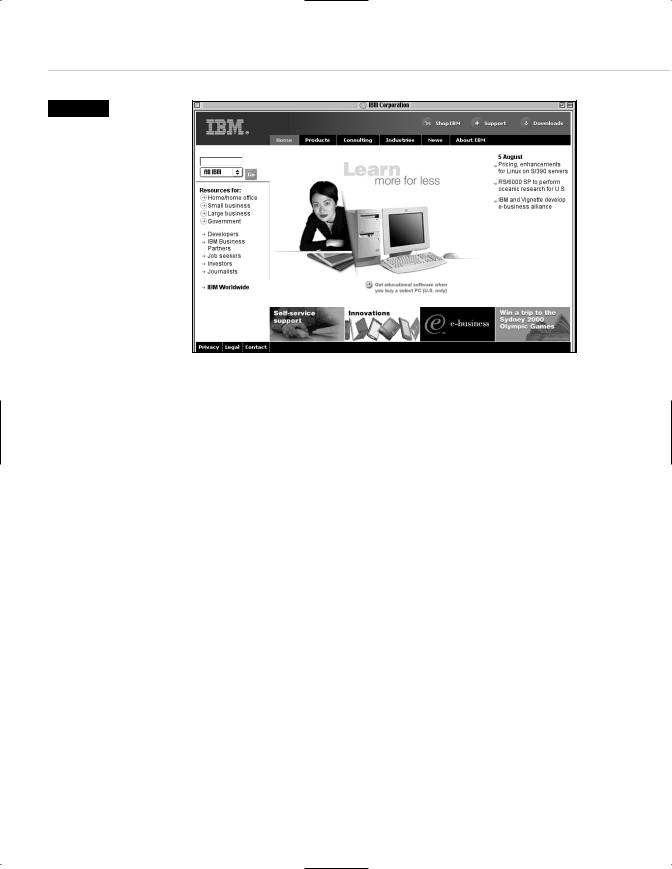
- •Taking Your Talent to the Web
- •Introduction
- •1 Splash Screen
- •Meet the Medium
- •Expanding Horizons
- •Working the Net…Without a Net
- •Smash Your Altars
- •Breath Mint? Or Candy Mint?
- •Where’s the Map?
- •Mars and Venus
- •Web Physics: Action and Interaction
- •Different Purposes, Different Methodologies
- •Web Agnosticism
- •Point #1: The Web Is Platform-Agnostic
- •Point #2: The Web Is Device-Independent
- •The 18-Month Pregnancy
- •Chocolatey Web Goodness
- •’Tis a Gift to Be Simple
- •Democracy, What a Concept
- •Instant Karma
- •The Whole World in Your Hands
- •Just Do It: The Web as Human Activity
- •The Viewer Rules
- •Multimedia: All Talking! All Dancing!
- •The Server Knows
- •It’s the Bandwidth, Stupid
- •Web Pages Have No Secrets
- •The Web Is for Everyone!
- •Swap text and code for images
- •Prune redundancy
- •Cache as Cache Can
- •Much Ado About 5K
- •Screening Room
- •Liquid Design
- •Color My Web
- •Thousands Weep
- •Gamma Gamma Hey!
- •Typography
- •The 97% Solution
- •Points of Distinction
- •Year 2000—Browsers to the Rescue
- •Touch Factor
- •Appropriate Graphic Design
- •User Knowledge
- •What Color Is Your Concept?
- •Business as (Cruel and) Usual
- •The Rise of the Interface Department
- •Form and Function
- •Copycats and Pseudo-Scientists
- •Chaos and Clarity
- •A Design Koan: Interfaces Are a Means too Often Mistaken for an End
- •Universal Body Copy and Other Fictions
- •Interface as Architecture
- •Ten (Okay, Three) Points of Light
- •Be Easily Learned
- •Remain Consistent
- •Continually Provide Feedback
- •GUI, GUI, Chewy, Chewy
- •It’s the Browser, Stupid
- •Clarity Begins at Home (Page)
- •I Think Icon, I Think Icon
- •Structural Labels: Folding the Director’s Chair
- •The Soul of Brevity
- •Hypertext or Hapless Text
- •Scrolling and Clicking Along
- •Stock Options (Providing Alternatives)
- •The So-Called Rule of Five
- •Highlights and Breadcrumbs
- •Consistent Placement
- •Brand That Sucker!
- •Why We Mentioned These Things
- •The year web standards broke, 1
- •The year web standards broke, 2
- •The year web standards broke, 3
- •The year the bubble burst
- •5 The Obligatory Glossary
- •Web Lingo
- •Extranet
- •HTML
- •Hypertext, hyperlinks, and links
- •Internet
- •Intranet
- •JavaScript, ECMAScript, CSS, XML, XHTML, DOM
- •Web page
- •Website
- •Additional terminology
- •Web developer/programmer
- •Project manager
- •Systems administrator (sysadmin) and network administrator (netadmin)
- •Web technician
- •Your Role in the Web
- •Look and feel
- •Business-to-business
- •Business-to-consumer
- •Solve Communication Problems
- •Brand identity
- •Restrictions of the Medium
- •Technology
- •Works with team members
- •Visually and emotionally engaging
- •Easy to navigate
- •Compatible with visitors’ needs
- •Accessible to a wide variety of web browsers and other devices
- •Can You Handle It?
- •What Is the Life Cycle?
- •Why Have a Method?
- •We Never Forget a Phase
- •Analysis (or “Talking to the Client”)
- •The early phase
- •Design
- •Brainstorm and problem solve
- •Translate needs into solutions
- •Sell ideas to the client
- •Identify color comps
- •Create color comps/proof of concept
- •Present color comps and proof of concept
- •Receive design approval
- •Development
- •Create all color comps
- •Communicate functionality
- •Work with templates
- •Design for easy maintenance
- •Testing
- •Deployment
- •The updating game
- •Create and provide documentation and style guides
- •Provide client training
- •Learn about your client’s methods
- •Work the Process
- •Code Wars
- •Table Talk
- •XHTML Marks the Spot
- •Minding Your <p>’s and q’s
- •Looking Ahead
- •Getting Started
- •View Source
- •A Netscape Bonus
- •The Mother of All View Source Tricks
- •Doin’ it in Netscape
- •Doin’ it in Internet Explorer
- •Absolutely Speaking, It’s All Relative
- •What Is Good Markup?
- •What Is Sensible Markup?
- •HTML as a Design Tool
- •The Frames of Hazard
- •Please Frame Safely
- •Framing Your Art
- •<META> <META> Hiney Ho!
- •Search Me
- •Take a (Re)Load Off
- •WYSIWYG, My Aunt Moira’s Left Foot
- •Code of Dishonor
- •WYS Is Not Necessarily WYG
- •Publish That Sucker!
- •HTMHell
- •9 Visual Tools
- •Photoshop Basics: An Overview
- •Comp Preparation
- •Dealing with Color Palettes
- •Exporting to Web-Friendly Formats
- •Gamma Compensation
- •Preparing Typography
- •Slicing and Dicing
- •Rollovers (Image Swapping)
- •GIF Animation
- •Create Seamless Background Patterns (Tiles)
- •Color My Web: Romancing the Cube
- •Dither Me This
- •Death of the Web-Safe Color Palette?
- •A Hex on Both Your Houses
- •Was Blind, but Now I See
- •From Theory to Practice
- •Format This: GIFs, JPEGs, and Such
- •Loves logos, typography, and long walks in the woods
- •GIFs in Photoshop
- •JPEG, the Other White Meat
- •Optimizing GIFs and JPEGs
- •Expanding on Compression
- •Make your JPEGS smaller
- •Combining sharp and blurry
- •Animated GIFs
- •Creating Animations in ImageReady
- •Typography
- •The ABCs of Web Type
- •Anti-Aliasing
- •Specifying Anti-Aliasing for Type
- •General tips
- •General Hints on Type
- •The Sans of Time
- •Space Patrol
- •Lest We Fail to Repeat Ourselves
- •Accessibility, Thy Name Is Text
- •Slicing and Dicing
- •Thinking Semantically
- •Tag Soup and Crackers
- •CSS to the Rescue…Sort of
- •Separation of Style from Content
- •CSS Advantages: Short Term
- •CSS Advantages: Long Term
- •Compatibility Problems: An Overview
- •Working with Style Sheets
- •Types of Style Sheets
- •External style sheets
- •Embedding a style sheet
- •Adding styles inline
- •Fear of Style Sheets: CSS and Layout
- •Fear of Style Sheets: CSS and Typography
- •Promise and performance
- •Font Size Challenges
- •Points of contention
- •Point of no return: browsers of the year 2000
- •Absolute size keywords
- •Relative keywords
- •Length units
- •Percentage units
- •Looking Forward
- •11 The Joy of JavaScript
- •What Is This Thing Called JavaScript?
- •The Web Before JavaScript
- •JavaScript, Yesterday and Today
- •Sounds Great, but I’m an Artist. Do I Really Have to Learn This Stuff?
- •Educating Rita About JavaScript
- •Don’t Panic!
- •JavaScript Basics for Web Designers
- •The Dreaded Text Rollover
- •The Event Handler Horizon
- •Status Quo
- •A Cautionary Note
- •Kids, Try This at Home
- •The Not-So-Fine Print
- •The Ever-Popular Image Rollover
- •A Rollover Script from Project Cool
- •Windows on the World
- •Get Your <HEAD> Together
- •Avoiding the Heartbreak of Linkitis
- •Browser Compensation
- •JavaScript to the Rescue!
- •Location, location, location
- •Watching the Detection
- •Going Global with JavaScript
- •Learning More
- •12 Beyond Text/Pictures
- •You Can Never Be Too Rich Media
- •Server-Side Stuff
- •Where were you in ‘82?
- •Indiana Jones and the template of doom
- •Serving the project
- •Doing More
- •Mini-Case Study: Waferbaby.com
- •Any Size Kid Can Play
- •Take a Walk on the Server Side
- •Are You Being Served?
- •Advantages of SSI
- •Disadvantages of SSI
- •Cookin’ with Java
- •Ghost in the Virtual Machine
- •Java Woes
- •Java Woes: The Politically Correct Version
- •Java Joys
- •Rich Media: Exploding the “Page”
- •Virtual Reality Modeling Language (VRML)
- •SVG and SMIL
- •SMIL (through your fear and sorrow)
- •Romancing the logo
- •Sounds dandy, but will it work?
- •Promises, Promises
- •Turn on, Tune in, Plug-in
- •A Hideous Breach of Reality
- •The ubiquity of plug-ins
- •The Impossible Lightness of Plug-ins
- •Plug-ins Most Likely to Succeed
- •Making It Work: Providing Options
- •The “Automagic Redirect”
- •The iron-plated sound console from Hell
- •The Trouble with Plug-ins
- •If Plug-ins Run Free
- •Parting Sermon
- •13 Never Can Say Goodbye
- •Separation Anxiety
- •A List Apart
- •Astounding Websites
- •The Babble List
- •Dreamless
- •Evolt
- •Redcricket
- •Webdesign-l
- •When All Else Fails
- •Design, Programming, Content
- •The Big Kahunas
- •Beauty and Inspiration
- •Index

142 WHO: What Is a Web Designer, Anyway?: What We Have Here Is an Opportunity to Communicate
Figure 6.1
Did the designers of IBM’s website (www.ibm.com) succeed in their quest to translate the IBM brand to the Web? Front-page graphics tell only part of the story. The site’s functional performance tells the rest. Web design encompasses graphic design but extends beyond it.
Restrictions of the Medium
Every medium has limitations. This book, for instance, lacks hyperlinks and a soundtrack. You can’t bookmark a motion picture (at least, not in the theater—the management might complain), and you can’t save printed magazine images to your desktop (though you can often save newsprint to your fingertips).
The Web’s restrictions, as well as its strengths, were discussed in Chapter 2. Respecting those limitations and playing to those strengths is a key difference between design and web design. A web page that ignores the medium’s restrictions (for instance, by forcing the viewer to download 100K of bloated imagery) or that fails to play to the medium’s strengths (for instance, by offering limited interactivity), may be visually beautiful— but it will still be poor web design.
Let’s look at the last part of our definition:
A web designer understands the underlying technology and works with team members and clients to create sites that are visually and emotionally engaging, easy to navigate, compatible with visitors’ needs, and accessible to a wide variety of web browsers and other devices.

Taking Your Talent to the Web |
143 |
Technology
Web designers have a lot to say about the appropriate technological level for sites they design. Choosing appropriate technology is part of your job as brand steward and user advocate. Consider the following:
■You wouldn’t design a general shopping site that depended on the visitor having the Flash plug-in, the latest version of Internet Explorer, or a particular operating system because you’d lose many customers that way. The owners of Boo.com, a technologically overwrought shopping site, learned this the hard way when their business imploded in 2000.
■On the other hand, when designing a gaming site for Playstation or an entertainment site for a high-tech sci-fi flick, using Flash (or designing for newer, more capable browsers) could be entirely appropriate.
■You or a developer on your team might have fun coming up with a nifty Dynamic HTML (DHTML) menu geared for Internet Explorer 5, Netscape 6, and Opera 5—three recent browsers that to greater or lesser degrees support the World Wide Web Consortium (W3C) standard Document Object Model (DOM). You would not create a menu like that, however, for a women’s health care center because patients and their families are not going to download a new browser when seeking medical help or information.
Technology choices are essentially decisions about who the site is for. As a communications professional, you should cultivate an informed opinion on this matter. If you don’t decide these issues for yourself, somebody else will decide for you, which can have potentially tragic results.
It’s also worth repeating that even if you decide the site is primarily for bleeding-edge web enthusiasts, you will want to create alternative pages that are accessible to anyone.

144 WHO: What Is a Web Designer, Anyway?: What We Have Here Is an Opportunity to Communicate
Works with team members
Although sites are often driven by a lead designer and technologist (or a lead information designer), web design is nearly always a group effort. Think of your team members as friends. In fact, think of them as family. You’ll probably see more of them than you do your friends and family anyway. Then again, as a designer, you may already be used to that.
Visually and emotionally engaging
Like we have to define this for you.
Like that ever stopped us.
Beyond functioning appropriately for its intended use and supporting the brand, if your site lacks visual appeal or a coherent and engaging message, all but the most dedicated users will pass it by in favor of a more fulfilling experience elsewhere.
“Form follows function” does not mean “form doesn’t matter.” Form matters a heck of a lot. Given two functionally equivalent sites, only one of which delights the eye, where would you choose to spend your time? Okay, you’re a designer. But given the same two sites, where would your Aunt Martha choose to spend her time? Okay, well, yes, we forgot about Aunt Martha’s problem. Anyway, you get the idea.
Visually appropriate does not mean visually unengaging. Most of the screenshots in Chapter 3 are of appropriately designed sites, very few of which are lackluster or emotionally unappealing. We adopt kittens but run from buzzards and rats because, well, to be honest, because buzzards and rats are filthy, disgusting animals—but also because kittens are cuter than buzzards and rats. We idolize babies and movie stars for much the same reason.
You did not go into design to make the world duller or uglier. Anyone who tells you a functional site has to be visually plain is suffering from an emotional problem. Don’t make their problem yours. (But don’t give them ammunition by designing a beautiful but hard-to-use site.)

Taking Your Talent to the Web |
145 |
Sites cannot be emotionally engaging if they don’t have a clear purpose and a distinctive, brand-appropriate look and feel. It also helps a great deal if they’re well written. Few commercial sites are. If you end up supervising budgets for some of your projects, be sure to leave money for good writers and editors. Great cinematography can only go so far when the script is bad.
Easy to navigate
Refer to Chapter 3.
Compatible with visitors’ needs
Refer to this chapter’s previous discussion of the three partners in any website (the designer, the client, and the end-user) and to Chapter 3, which covers scenario development as a means of getting inside the user’s head.
We get inside the user’s head (to the best of our abilities, anyway) to structure and design a site that meets that user’s needs. Aside from your Uncle Marvin’s personal home page, no site appeals to just one user. We construct multiple scenarios to forecast the needs of multiple users.
Accessible to a wide variety of web browsers and other devices
We’ve already pointed out that the Web is accessed by a wide range of browsers and that each of them has peculiarities, also referred to as incompatibilities. (Other words are also used, but we gave up swearing for Lent.)
Until all browsers support a core group of common standards, you will have to learn the ins and outs of each distressingly different browser and con-
firm what you think you know by testing your completed designs on as many browsers and platforms as possible. (We’ll discuss testing in the next chapter.) In addition, your sites might need to work in nontraditional browsers and Internet devices such as Palm Pilots and web phones.
